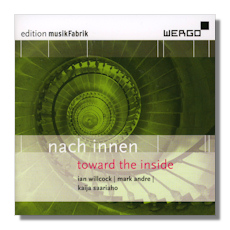
The Internet's Premier Classical Music Source
Related Links
- Saariaho Reviews
- Latest Reviews
- More Reviews
-
By Composer
-
Collections
DVD & Blu-ray
Books
Concert Reviews
Articles/Interviews
Software
Audio
Search Amazon
Recommended Links
Site News
 CD Review
CD Review
Nach Innen

"Toward The Inside"
- Ian Willcock: grave
- Mark Andre: ni*
- Kaija Saariaho: Graal théâtre, for Violin & Orchestra**
** Hannah Weirich, solo violin
musikFabrik/James Wood
* musikFabrik/Rupert Huber
** musikFabrik/Peter Rundel
Wergo 6856
Nach innen means "towards the inside" in German. This exciting and imaginative CD from Wergo presents three relatively short, and self-contained contemporary instrumental pieces which aim to explore (perhaps to advocate) the primacy of internal processes, of seeking inside oneself for truth. Certainly to concentrate on the internal nature of sound. Perhaps not easy music to relate to, each of these three pieces is stimulating and original; and each is extremely well played and/or realized by soloists in the pieces by Willcock (Benjamin Spillner, violin; Ned McGowan, flute; Virginie Tarrete, harp; Maria Spengler, violin; and Seth Josel, guitar) and Saariaho (John Corbett, clarinet; Mirjam Schroder, harp; Severine Ballon, cello; Tinta Schmidt von Altenstadt, violin; Gesa Johanns, horn; and Maaike Aarts, violin), and the Cologne-based ensemble founded in 1990, musikFabrik, in all three. Music of this complexity and forthright diversion from many norms of construction needs sympathetic and technically-accomplished playing. Thanks to the personnel employed here it gets it.
British composer, Ian Willcock's (b. 1959) piece uses "roars" of sound and percussive ostinati to drag the listener into what the informative booklet calls "… fathomless spheres where chaos still reigns". Interestingly, Willcock's sounds are electronically distorted (using ring modulation) then re-scored for acoustic instruments. The mathematical principles which also inform the evolution in time of the piece are no less real than the use which certain of the instruments make of utterances – most notably, "The Rest is Silence" – to evoke the finality of farewell; that's a concept which has to be seen as a form of inwardness too. In this case, that's Willcock's allusion to a last visit to Sigmund Freud by the latter's friend Ernest Jones. Hence the multiple meanings of the work's titles.
Willcock's grave is as loud (not raucous) and insistent as Mark Andre's (b. 1964, France) ni is gritty and grainy. Like an old sepia or monochrome photograph ni (acronym for "nach innen") scratches and pulls its way through the composer's own avowal of the importance of a journey whose concentration is as vital as its direction: hence the pared down and at times searing palette of sounds. This perspective allows Andre to magnify one small aspect of (a) sound in order to extract more musical force and impact than might at first seem likely, or even profitable. Significantly, several families of instruments in turn replicate similar such "sonic situations". At the same time, and in a deliberately conceived parallel time frame, the instruments "meet" one another by resonating into what can be seen as a "meta-instrument". This is better heard than described. The musicians of musikFabrik conducted here by Rupert Huber (each piece on the CD has a different conductor) understand and endorse this process well.
Kaija Saariaho's Graal théâtre, for violin and orchestra is more conventionally lyrical. Although in many places the violin is used almost percussively as well. But it's a percussion more akin to the beating of raindrops than to thunder; so of course the regularity becomes as melodic as it does beaten. Hannah Weirich's performance is remarkable with as much energy as sensitivity. And more introspection and reflection than rhetoric. Given the wide compass of the language (the dramatic slowed arpeggio passage a couple of minutes from the end of the first movement [tr.9], for instance, and descent of the scale towards the work's end) such discipline is not easy: the temptation to push sound at the listener, rather than let its real meaning emerge has been avoided entirely. This is the longest single work on the CD at over 25 minutes. For all its penetration and theatricality, the players here stay admirably close to Saariaho's mission of daring a violin concerto at the start of the twenty-first century. The apparent historical anomaly, she and they are saying, is no more inappropriate or inaccessible than is author Jacques Roubaud's retelling of the Arthurian legends, on which the piece draws its inspiration. But – and this is the essence of this enjoyable and persuasive CD – once the initial jar of working in whichever medium has been chosen is accepted, your ear, mind and heart must (and do – thanks to the extremely high quality of musicianship here) concentrate on what it's conveying; not on the fact that it's conveying it.
The beauty of the Saariaho work in particular is likely to stay with you for quite some time. If you're keen to explore music that successfully achieves a defined and worthwhile purpose, that's both played and recorded in stylish, idiomatic and decidedly ways, that makes no claims which it can't substantiate, then you should look seriously at this CD. It's far from being an overblown "concept" product. Although the notes that provide an otherwise very sensible commentary on the music are a little "purple" in places, it's well-produced and ought to make you seek out more from the composers represented here.
Copyright © 2011, Mark Sealey.





















